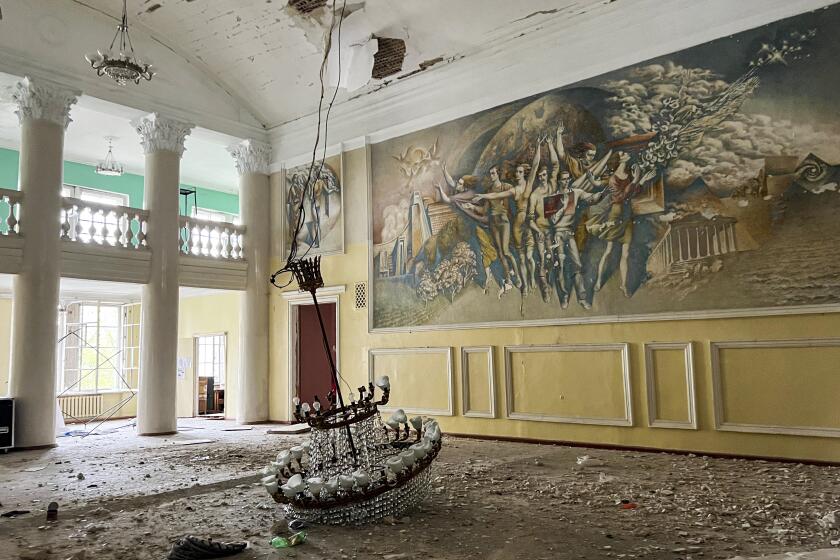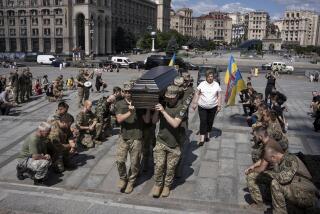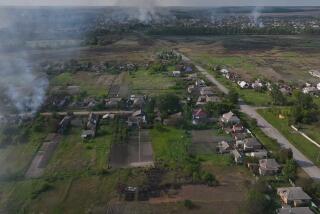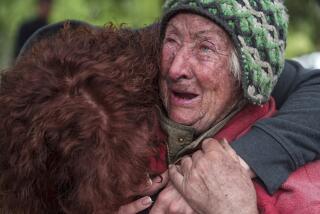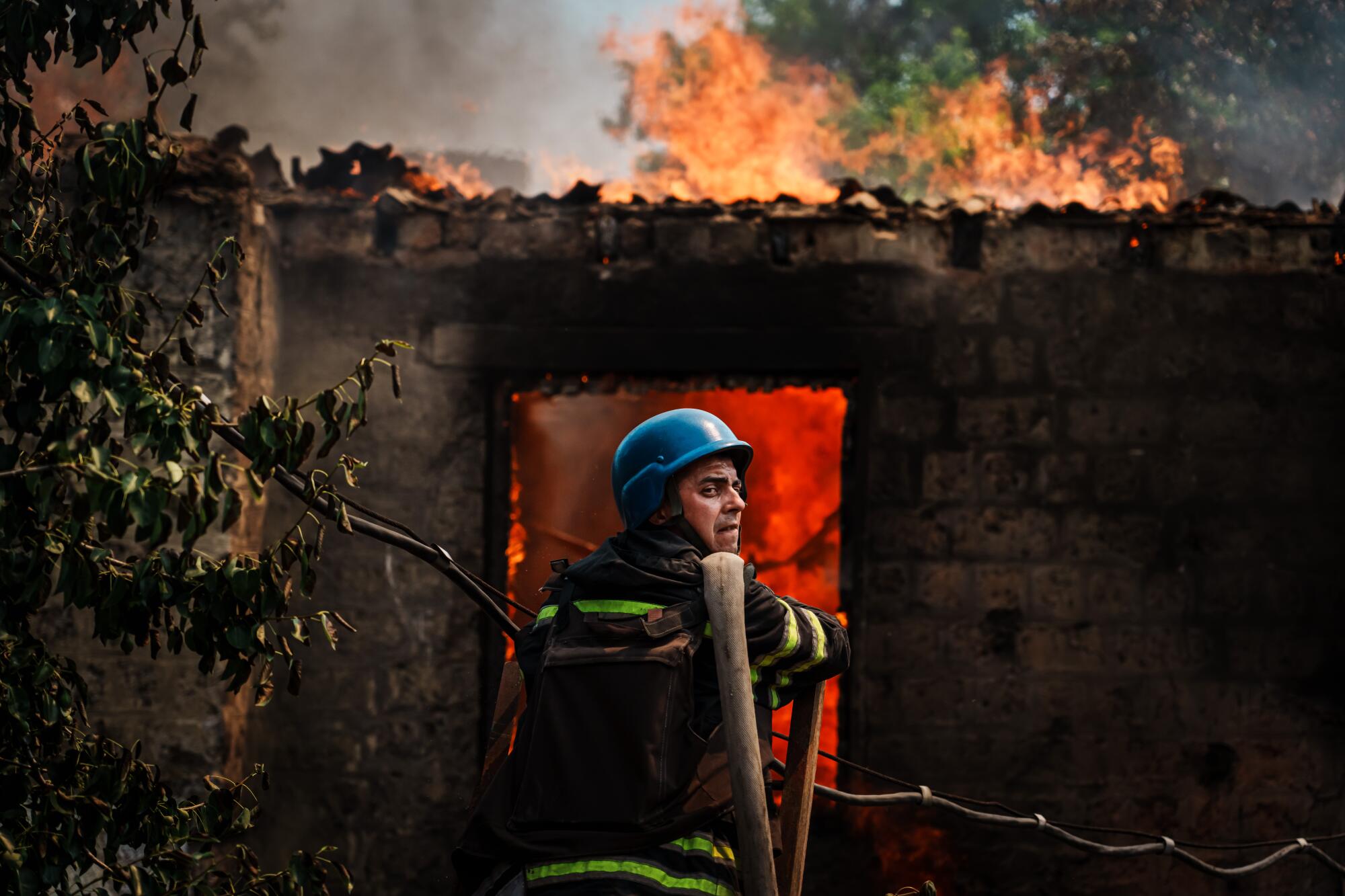
- Share via
LYSYCHANSK, Ukraine — How does a city die? To find out, turn to Severodonetsk, at the very edge of the Ukrainian government’s control on the eastern front, and currently the focal point of the fight between its soldiers and the Russians who have invaded.
Viewing Severodonetsk from across the river that separates it from its sister city Lysychansk, one witnesses the spasms in real time: Almost a dozen columns of smoke wreathe the skyline where tons of Russian ordnance smash through a building and start a fire, the flames twinkling in the distance like a votive candle. The soundtrack of the warfare— the bangs of artillery, the guttural whoosh of rockets launched in rapid succession, the snare-drum beat of heavy machine guns — signals fresh destruction to both cities.
“You never get used to it. It’s always terrifying,” said Natalya Sakolka, a 55-year-old mining engineer and administrator in Lysychansk, standing with a few neighbors in the backyard of her apartment building.
She grimaced every time a boom sounded. She grimaced often.
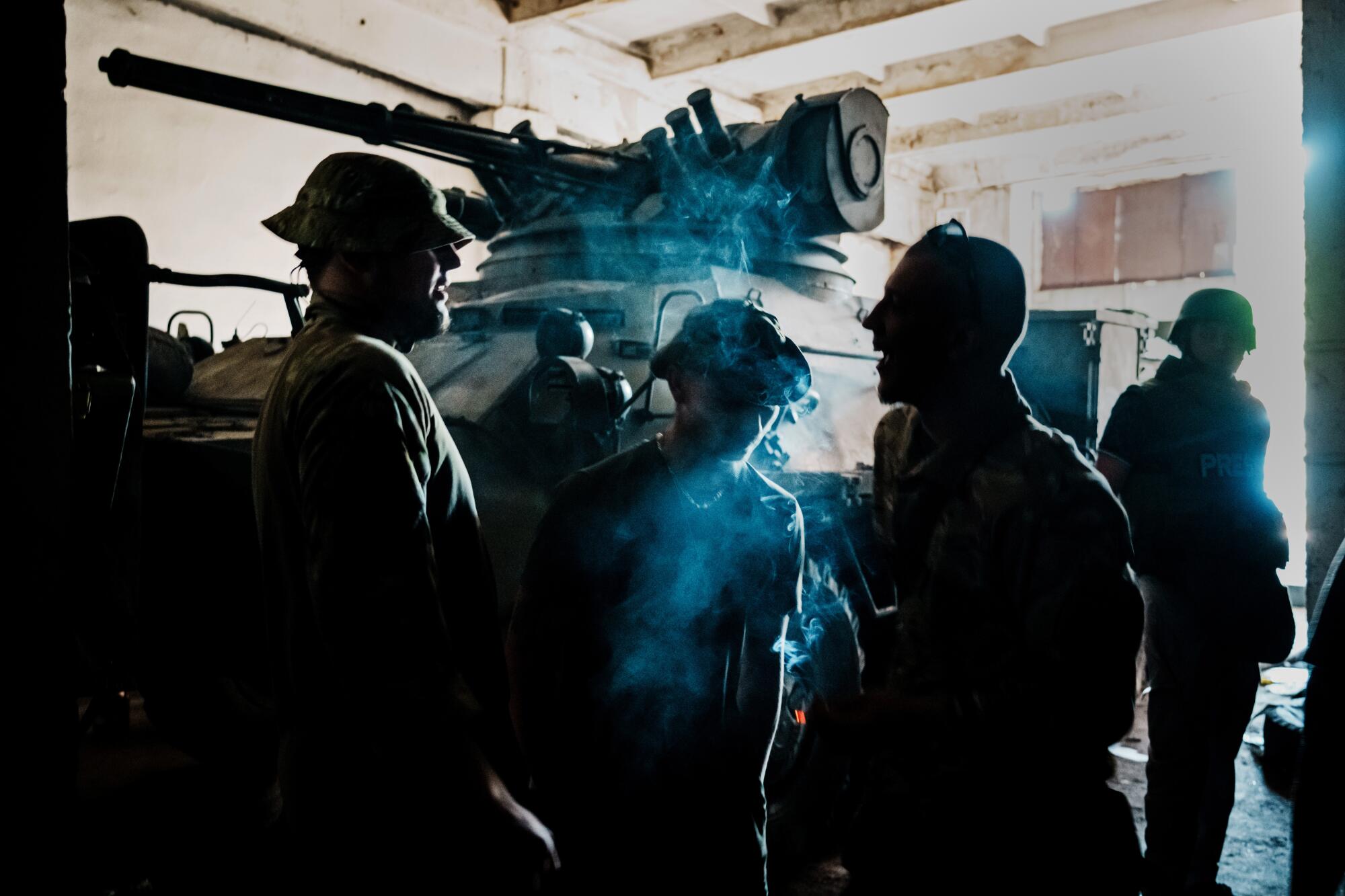
Ever since Moscow turned its sights on the Donbas, which encompasses the war-riven east Ukrainian provinces of Luhansk and Donetsk, the city of Severodonetsk, Kyiv’s seat of power in Luhansk, has been a key target. In the months since its late February invasion of Ukraine began, the Russian army has made a torturously slow — but steady— advance in the east, unleashing the full power of its artillery arsenal and pummeling its way to almost full control of Luhansk.
It has been more than a month since Russian troops advanced on Rubizhne, a small, well-appointed city nestled in a verdant slice of land. Families have taken refuge in a bombed cultural palace.
Severodonetsk, together with Lysychansk, represent the last 3% of the province.
In May, a combined force of Russian troops, separatists and Kremlin-allied Chechen fighters blitzed into the city, taking a series of Ukrainian positions in residential neighborhoods. Now, they’re locked in a bare-knuckled street brawl with Ukrainian defenders bunkered no more than 300 yards away even as artillery thunders above them, turning onetime industrial hubs into what Ukrainian President Volodymyr Zelensky described in a recent speech as “dead cities.”
The signs are obvious: There’s no electricity, let alone internet or phone service. Gas is cut off and, most crucially, so is water. An estimated 85% of the 220,000 residents here have fled, with those remaining largely the poor, the infirm and the elderly, as well as their caretakers.
But you won’t see them on the streets. Only a few residents, along with uniformed personnel, dare go above ground to scrounge supplies from the few shops in Lysychansk still open, or queue for assistance packages and water deliveries trucked into neighborhoods by the police or fire departments.
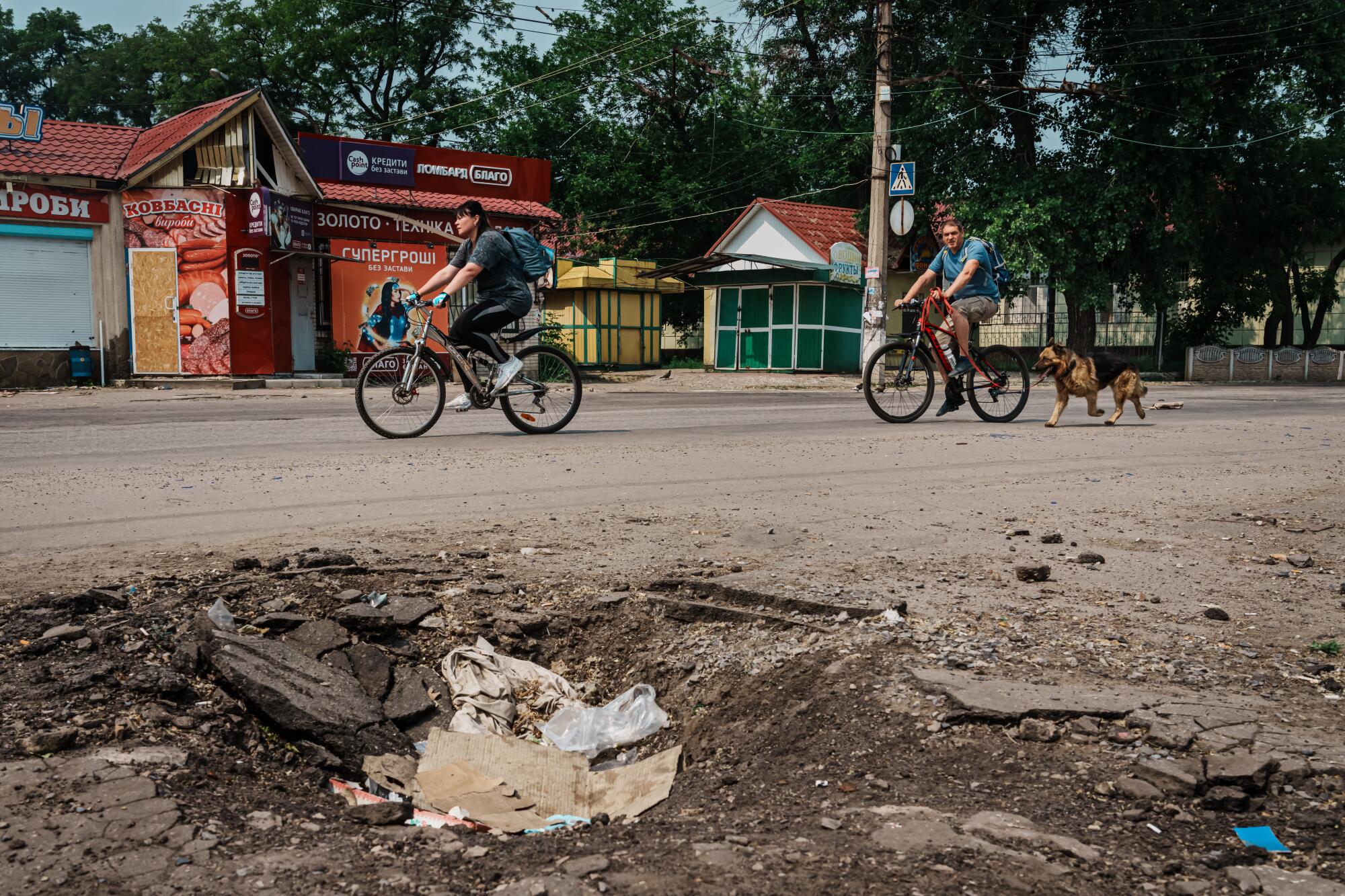
Driving is a fraught, nerve-racking game: With artillery batteries assisted by drones hunting for prey, the banshee-scream of incoming Russian ordnance reverberates often across the deserted boulevards. The warning sounds come too shortly for one to do anything but hurtle to the ground, hoping to be far enough and hidden enough to avoid shrapnel.
It’s a game in which the Ukrainians are almost hopelessly outmatched, they say.
“This is not a war of soldiers. It’s a war of artillery. The difference in approach between us and them is that they don’t have to count their ammo while we have to save it,” said Luhansk Police Chief Oleh Hryhorov, a laconic man who has remained — along with his officers — on the job to maintain order in the decreasing patch of territory under government control.
“To compare,” he said, “they’re using one ton; we’re using a kilogram. So they’re just burning everything.”
Facing such a barrage, whether in the Donbas or on other fronts, has been costly. This month, Zelensky said 100 of his soldiers were dying in combat every day; other officials say the figure is now double. The constant stream of armored ambulances racing from the front lines to the Lysychansk military hospital hints at the toll.
Those losses have spurred Ukrainian officials to plead with Western nations for more ammunition and better weapons, especially long-range multiple- launch rocket systems, or MLRS.
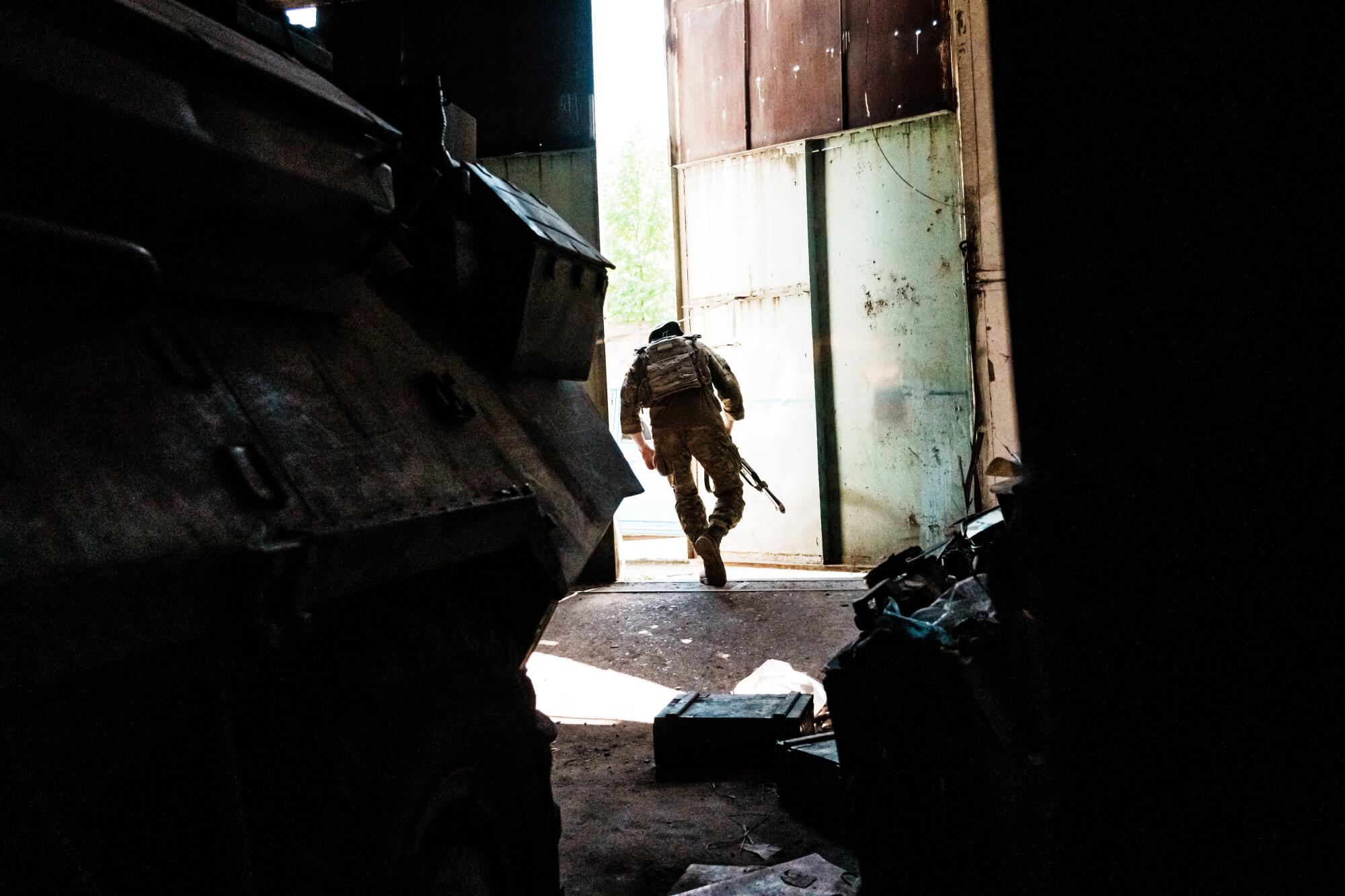
“We have Russian logistical hubs nearby that we can’t reach. Why? Because we don’t have enough weapons,” said Mariana Bezuhla, the deputy head of Ukraine’s parliamentary committee on national security. She spoke in a government building in Lysychansk, where she was helping coordinate evacuations from there as well as Severodonetsk.
“We wouldn’t be in this situation if we had the MLRS months ago,” she said. “And for what? Why the delay? Or course there’s a concern about such tempo.”
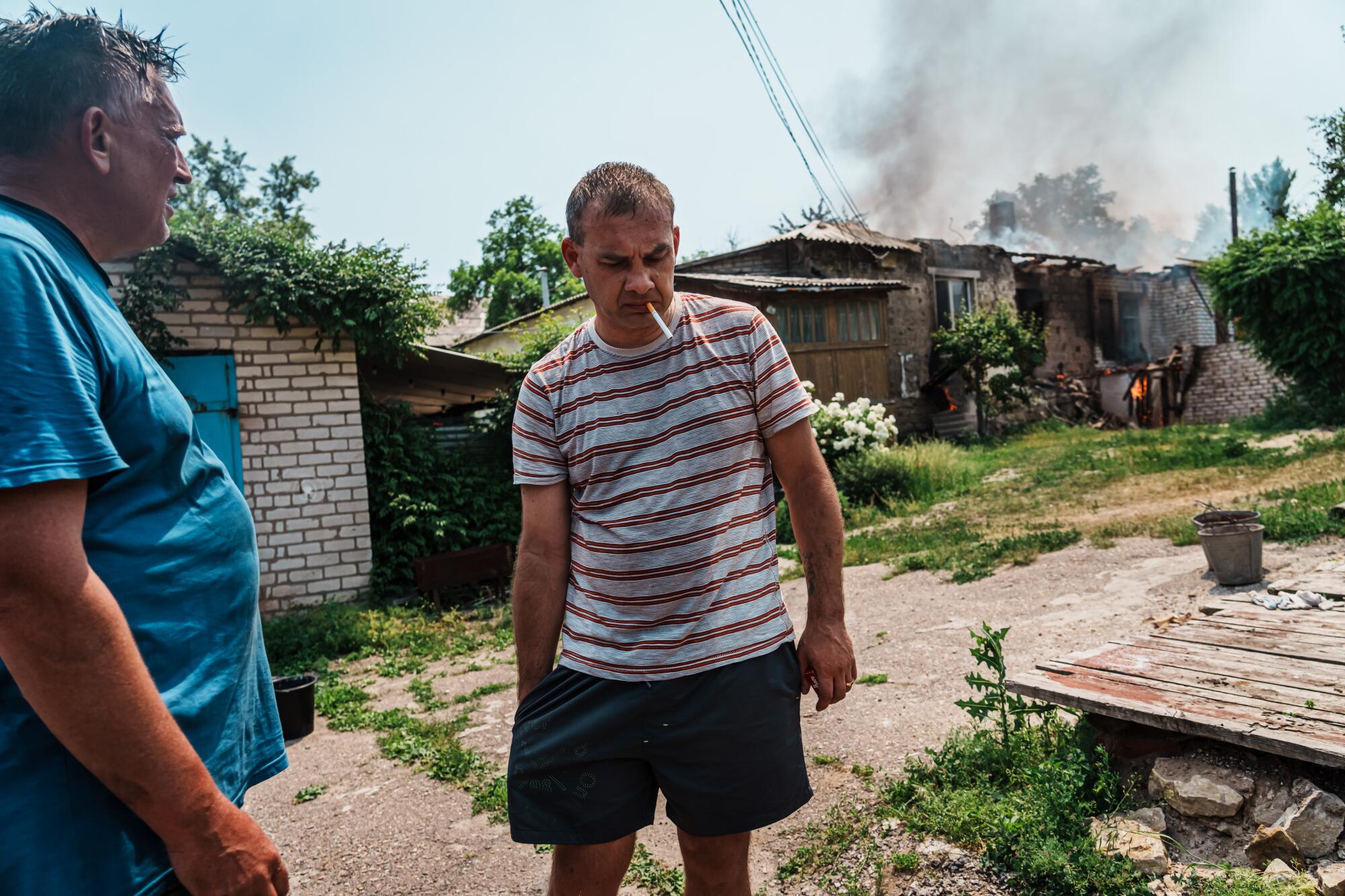
On Saturday, a series of shells arced into a neighborhood nestled on a hill in Lysychansk that faces Severodonetsk. One of them slammed into 44-year-old Nikolai’s house. None of his family — his wife, Victoria, and three children, Arseniy, Vladislav and Yelizavyeta (they gave only their first names for reasons of privacy) — were hurt, but a fire blazed and spread rapidly across the roof. With a neighbor, Nikolai tried to douse the flames with whatever water they had been able to collect in recent days.
It wasn’t enough: Soon a hole opened up in the ceiling, dumping a shower of ash and red-hot embers into a corridor while Nikolai ran in and tried to gather up some of his family’s belongings. Watching the fire engulf one of the rooms, Victoria began to cry, screaming through tears of rage, “My home, my home is gone!”
By the time a lone firetruck showed up — it was the only one still undamaged, department officials said, adding that they deal with 10 to 15 fires a day, all caused by shelling — there didn’t seem much left to save. Nikolai watched with a sad smile as a weak stream of water came from the hose; it barely reached the blaze.
“It’s like they’re watering a garden,” he said of the firefighters, before turning away and taking another drag of his cigarette.
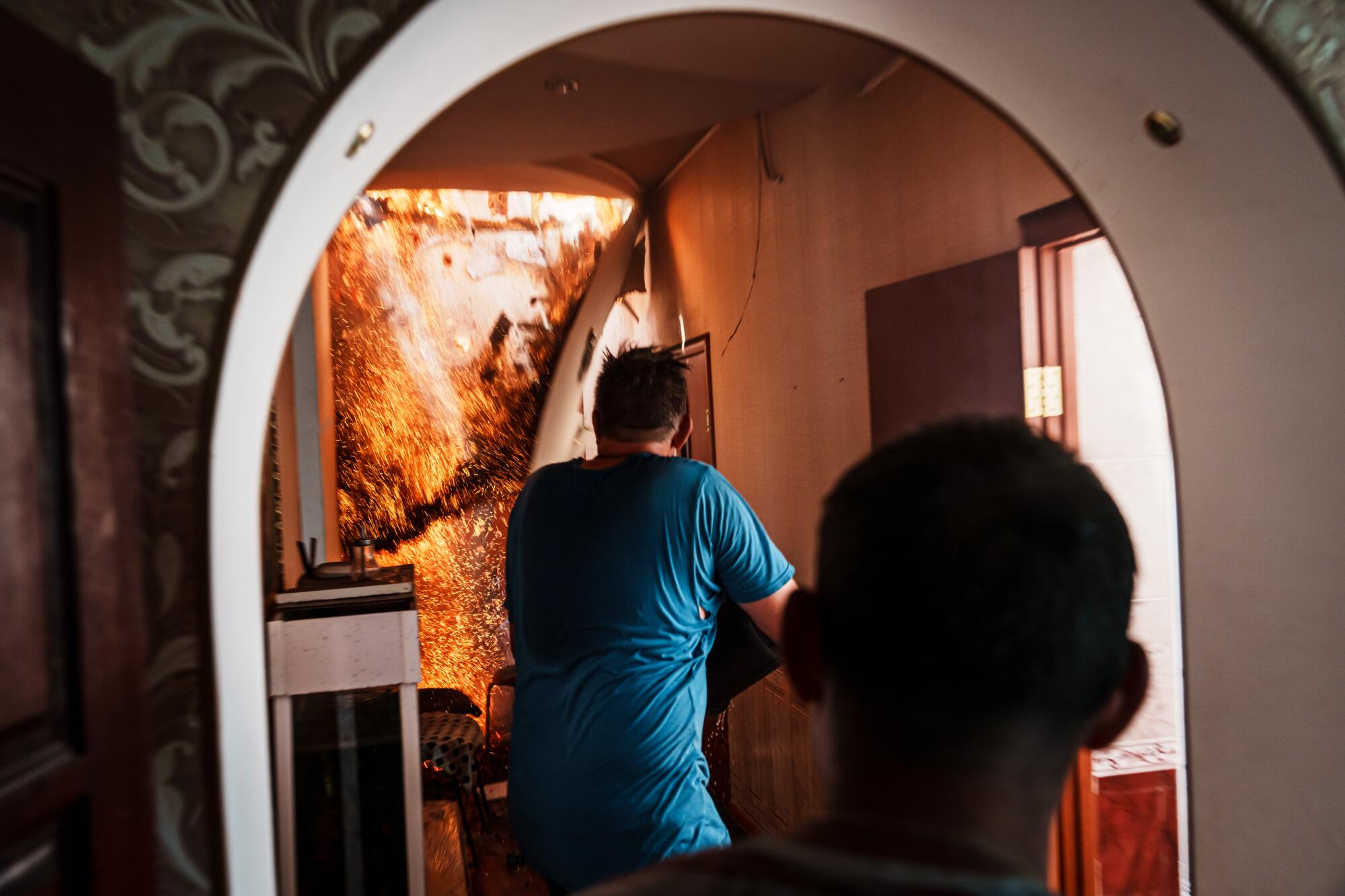
Despite the calamity, he and his family would stay, he said. Nikolai worked as a section manager at a nearby plant but didn’t have enough money saved to move out. He also appeared to have little faith in Ukrainian authorities, wondering out loud if it was a Ukrainian round that had struck his home.
Many of those who have stayed appear nonchalant about the prospect of Russian rule. And some are resolutely pro-Moscow, said Artyom, a 20-year-old soldier who gave only his first name for security reasons. He was stationed as part of an armored vehicle crew in Lysychansk.
During the fighting for a town adjacent to Severodonetsk, Artyom and his comrades came under heavy shelling near a house. They tried to run in for protection, but the woman who owned it refused to help.
“She wouldn’t let us inside. She called us fascists, Nazis,” he said.
Such attitudes have given the Russian army an edge it didn’t have in its earlier forays around Kyiv and Kharkiv, where residents would report Russian troop movements to Ukrainian authorities to help destroy them. Here, the situation is reversed, said Mohammad Dagestani, 32, who said he was from the Dagestan republic of Russia but was part of a Ukrainian intelligence unit near Lysychansk.
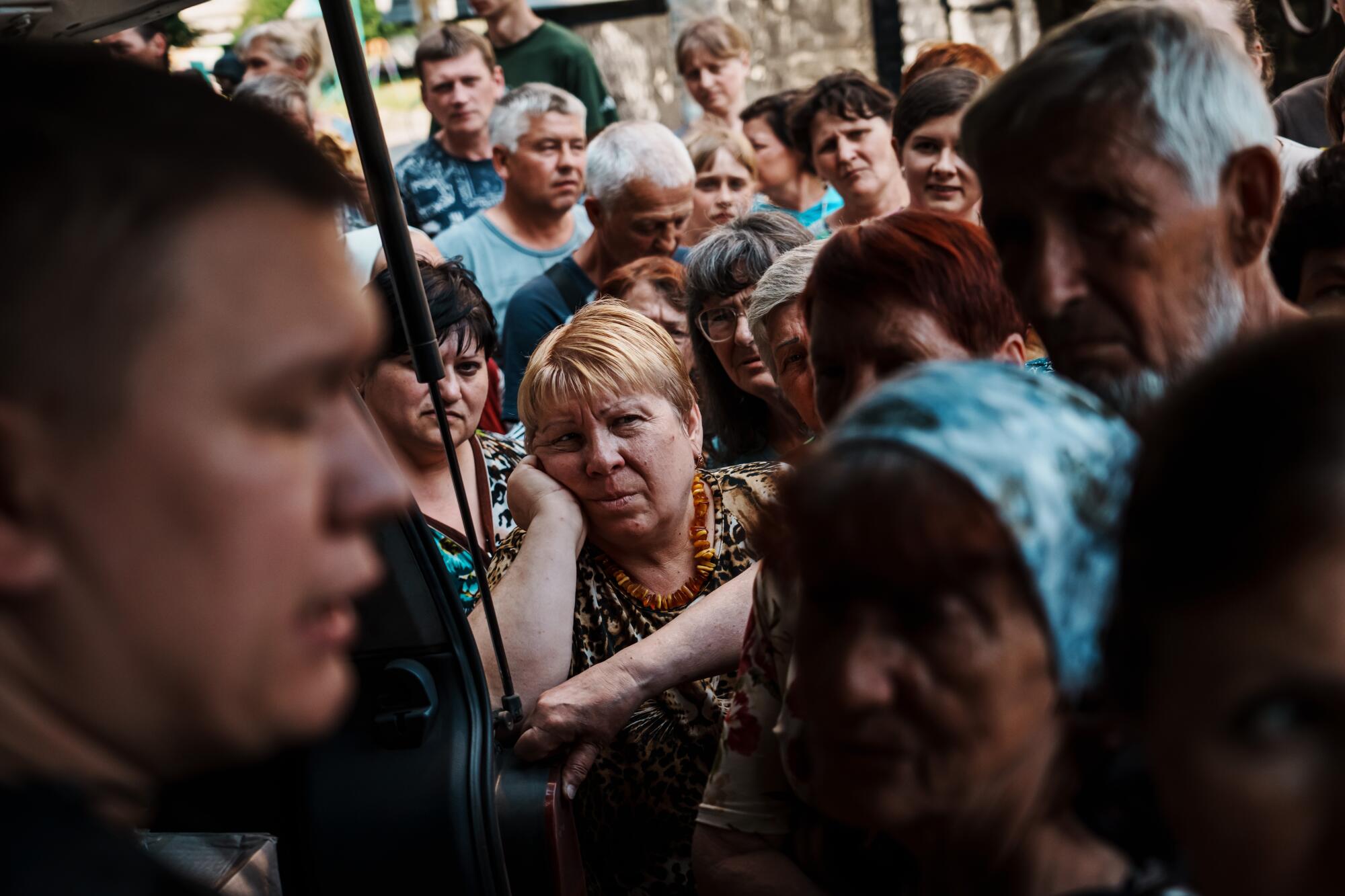
“They’re all Russian spies here,” he said, watching a lone cyclist go past the Lysychansk stadium where he and a few others had parked. When the cyclist disappeared round a corner, the group’s commander, Ahmad Akhmedov, urged everyone back into the vehicle and drove to another position at the edge of town. Soon enough, the booms of artillery began to pepper the stadium’s perimeter.
“If we have to withdraw from here, there are some people I’m going to shoot dead before we go because they’re so Russian,” Akhmedov said. “They’re just waiting for the new master to arrive.”
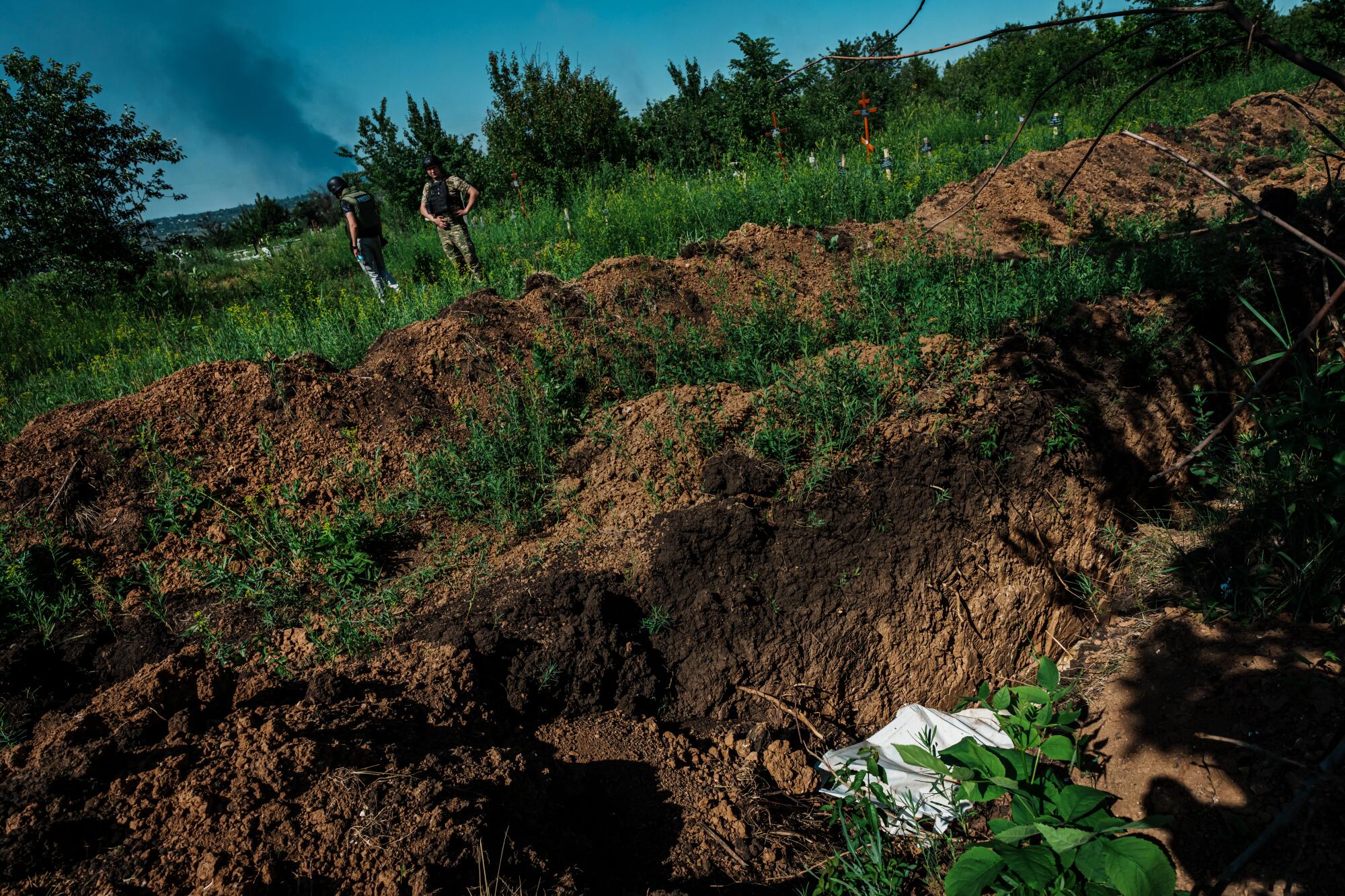
In the meantime, the slow death of the two cities drags on. On Saturday, the artillery barrage claimed the life of one woman, authorities said. Her body would probably join others buried in a mass grave situated in a quiet orchard off of the Heroes of Stalingrad street, in a suburb a 15-minute drive from Lysychansk’s center.
There, workers had dug three 6-foot-deep trenches. One had already been covered with dirt, but the other was exposed, with more than 30 body bags piled haphazardly in the groove. A third lay empty. A fleet of flies buzzed and the occasional gust of wind failed to reduce the nose-wrinkling scent of decomposing corpses.
“We have more than 180 people here in total, all from shelling,” said Yuri, a police officer who turned solemn as he walked among the graves.
“Most of them are identified, but some of them we can’t, because there was too much damage.”
He trudged back to the road. Even here you could hear the booms of the battle echoing over the fields. In the distance, a fresh cloud of smoke bloomed above Severodonetsk, catching the rays of the late afternoon sun.
More to Read
Sign up for Essential California
The most important California stories and recommendations in your inbox every morning.
You may occasionally receive promotional content from the Los Angeles Times.
